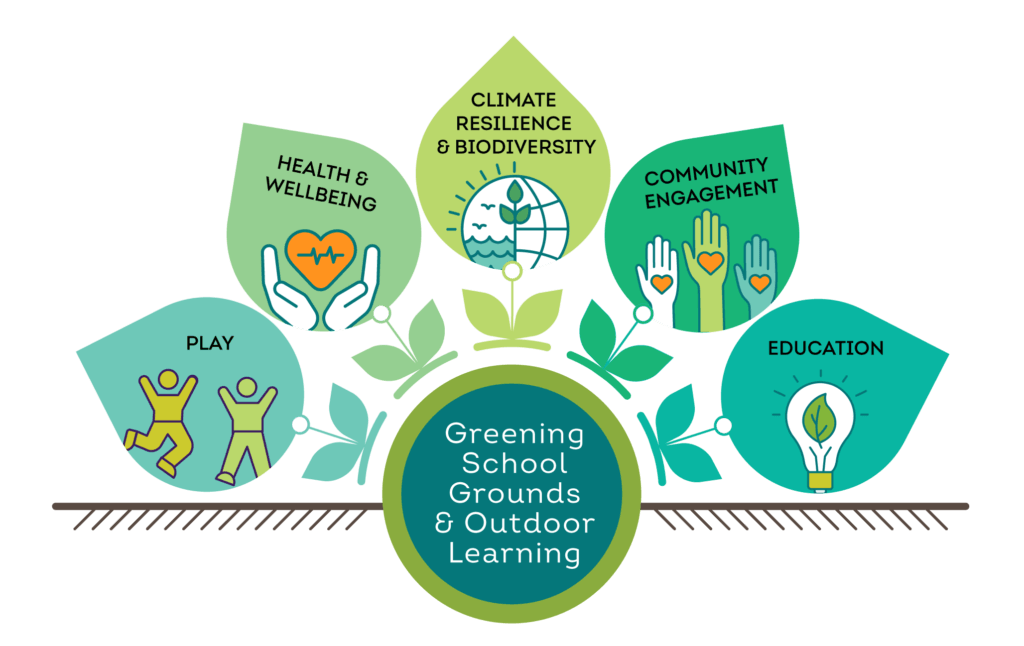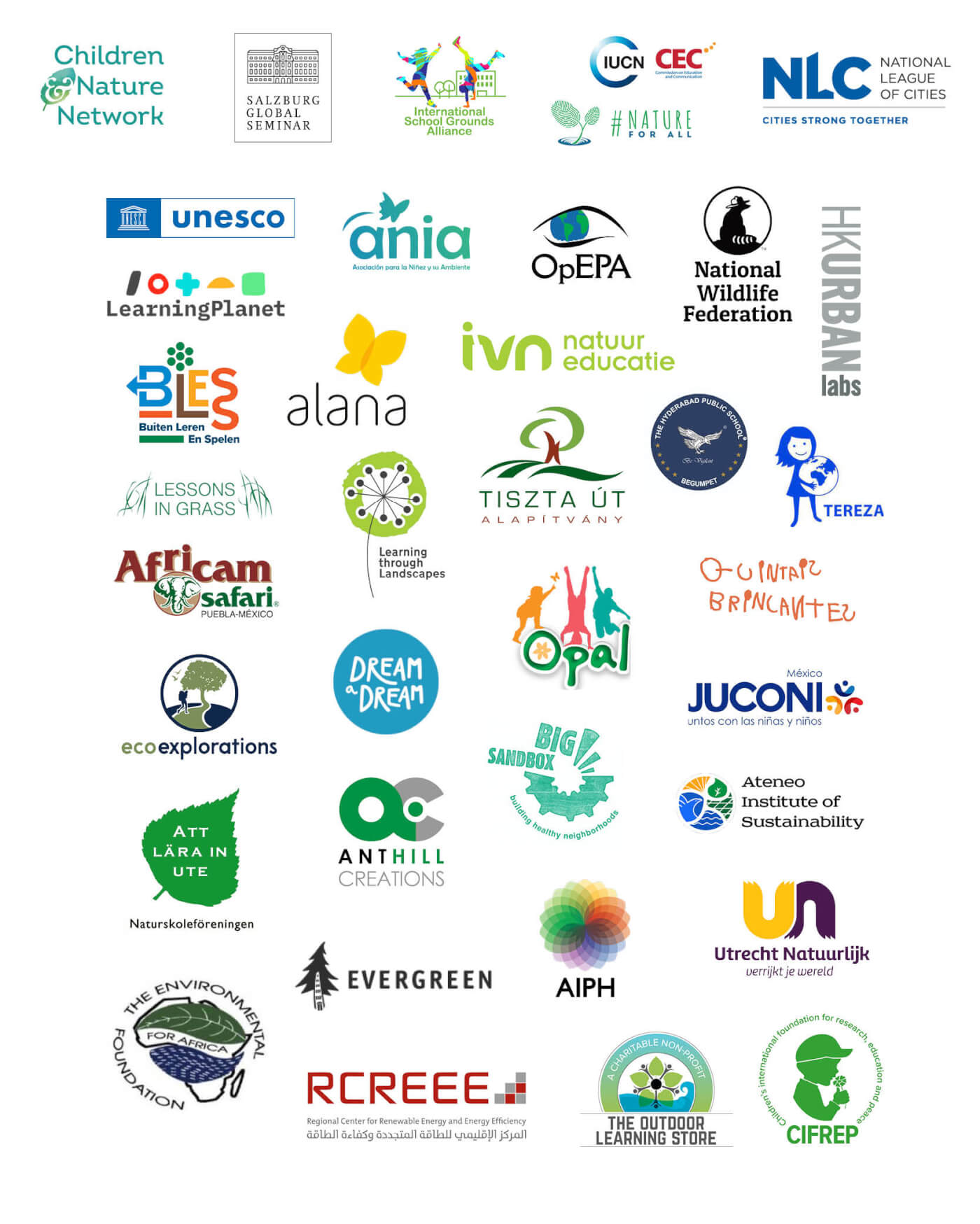Greening School Grounds & Outdoor Learning
Global Action Agenda
Improving health and education outcomes for communities
while increasing climate resilience
Endorse the Greening School Grounds & Outdoor Learning Global Action Agenda
We invite any organization or individual interested in advancing the vision of a world where every child — especially the most vulnerable — engages in nature every day.
Our Vision
We envision a world where every child — especially the most vulnerable — connects meaningfully with nature every day.
Background
The Greening School Grounds & Outdoor Learning project engaged global leaders and practitioners to build networks of like-minded organizations and individuals to identify scalable strategies and deepen our understanding of how to support the worldwide movement of school ground greening.
Since November 2021, the Children & Nature Network, in partnership with Salzburg Global Seminar, the International School Grounds Alliance, International Union for Conservation of Nature, #NatureForAll, and the National League of Cities Institute for Youth, Education and Families, identified and disseminated successful approaches from around the world to influence and help us, as a society, make significant progress in addressing complex, interrelated problems.
If children are to connect with nature every day for growing, playing and learning, school grounds must be part of the solution. Nature can exist throughout communities, but we know that daily experiences in nature are incredibly important for children’s mental and physical health and cognitive development. Therefore, we recommend that school grounds be considered a place where nature should be and children should have access to that nature.
Green school grounds and outdoor learning provide benefits in five key areas:

Find case studies and resources from around the world with the Greening School Grounds & Outdoor Learning initiative.
“Imagine if every school worldwide allowed children and young people to engage meaningfully with nature. The societal and climate challenges that children and young people face today demand we rethink and reimagine our learning environments and focus on transforming our education system, emphasizing practices that foster a love for nature, value change and inspire students and entire communities to contribute to a collective human and planetary well-being.”Swetha Stotra Bhashyam, Global Youth Biodiversity Network
What is Greening School Grounds & Outdoor Learning?
We define the greening of school grounds as the practice of adding nature to school grounds to improve children’s well-being, learning, and play while contributing to community engagement and climate resilience. While the nature and scope of features in each space vary significantly across geographic regions, children’s direct contact with nature is a key unifying factor.
The Play, Learn and Teach Outdoors Network (PLaTO-Net) defines outdoor learning as any learning that takes place outdoors. Outdoor learning can occur through various leisure, recreational, educational, occupational, and health-enhancing activities in natural or built outdoor environments.
Green school grounds can include:
|
|
To increase greening school grounds and outdoor learning practices worldwide that advance our vision of a world where every child — especially the most vulnerable — connects meaningfully in nature every day, we, the undersigned, believe that the following actions are required. The actions below also align with many global focus areas, including the United Nations Sustainable Development Goals, the Global Biodiversity Framework, the United Nations Decade on Ecosystem Restoration, and the Transforming Education agenda. Please note the action items are numbered for reference only and are not indicative of prioritization.
Advocacy and Participation
ACTIONS:
-
-
- Collect the impact and metrics of green school grounds, play and outdoor learning for children, communities and environment.
- Develop a platform for supporting organizations to advocate for, participate and invest in greening school grounds, outdoor play, and learning.
- Create a database of supporting organizations for people to connect with others open and willing to collaborate on this work.
- Provide a widespread and foundational understanding of the value of nature-based outdoor learning and playing through key systemic pathways — via teachers, principals, school leadership, parents, architects, health professionals, protected land managers, and media.
- Encourage community members, parents and organizations to support the design, maintenance and use of green school grounds for outdoor learning and play.
-
Inclusive Engagement
ACTIONS:
-
-
- Integrate children, educators and community members in the design process for their school grounds; promote and value their ideas.
- Listen to children, when they speak and with all their expressions, through surveys and consultation.
- Create capacity-building tools to support co-designing school grounds with children.
- Value and prioritize Indigenous, local and culturally relevant ways of knowing.
- Value and prioritize action that address the inclusion of children and educators with disabilities.
- Create a multilingual platform to support educators through pre-service education and in-service training.
- Encourage collaboration of communities and organizations in creating and managing green school grounds.
-
Funding and Governance
ACTIONS:
-
-
- Identify and secure funding for the global movement’s infrastructure.
- Support local organizations to improve their fundraising skills.
- Provide examples of sustainable private and public funding sources to develop school grounds at the local level.
- Set up innovative funding mechanisms such as carbon offsets or Corporate Social Responsibility (CSR) policies to fund school ground development that supports biodiversity, addresses climate change and enhances learning opportunities.
-
Policy
ACTIONS:
-
-
- Outdoor learning and play become part of the norm in education, with the school grounds and nearby natural areas being seen as a valuable place to implement curriculum.
- School grounds are seen as part of climate resilience strategies — capturing C02, mitigating urban heat island effects, increasing biodiversity and managing rainwater.
- Develop evidence-based tools and resources for key stakeholders including policymakers, community members, parents, educators, and funders to spark policy change for greening school years and outdoor learning spaces in communities with a focus on underserved neighborhoods.
- Open school grounds as park-like places for the greater community outside of school hours. Consider using spaces outside of school when school grounds are not available.
- Address nuances in education systems for integrating school ground greening and outdoor learning in diverse settings and contexts, including urban/rural, public/private, global North/South, and funding priorities.
- Create recommendations for policy at all levels, supported by evidence of greening school ground and outdoor learning fostering cognitive development, social emotional well being, physical health and risk negotiation skills.
- Prioritize equity and vulnerable communities.
- Create and adopt contextually appropriate design guidelines, local risk benefits, outdoor learning and play policies for local school systems, prioritizing vulnerable communities.
-
The Greening School Grounds & Outdoor Learning Global Action Agenda was written by Salzburg Global Fellows to support the work that ensures that all children and communities have access to green school grounds and outdoor learning. The development of this agenda was made possible by a grant from the Robert Wood Johnson Foundation. The views expressed here do not necessarily reflect the views of the Foundation.




